Myth 5: The private sector is more efficient than the public sector
 Dinyar Godrej has been associated with New Internationalist since 1989, but joined as an editor in 2000. His interest in human rights has led him to focus on subjects like world hunger, torture, landmines, present day slavery and healthcare. His belief in listening to people who seldom get a chance to represent themselves led to unorthodox editions on (and by) street children and people with disabilities from the Majority World. He grew up in India and remains engaged with South Asian affairs. Dinyar wrote the original No-Nonsense Guide to Climate Change (2001) and edited Fire In The Soul(2009).
Dinyar Godrej has been associated with New Internationalist since 1989, but joined as an editor in 2000. His interest in human rights has led him to focus on subjects like world hunger, torture, landmines, present day slavery and healthcare. His belief in listening to people who seldom get a chance to represent themselves led to unorthodox editions on (and by) street children and people with disabilities from the Majority World. He grew up in India and remains engaged with South Asian affairs. Dinyar wrote the original No-Nonsense Guide to Climate Change (2001) and edited Fire In The Soul(2009).
Addendum
Economic myths die hard because they are enshrined in the textbooks and practices of capitalist economists, repeated endlessly by bourgeois politicians, and unquestioningly endorsed by the corporate media.
By Patrice Greanville
Although Russia finally transcended the “savage capitalism” phase imposed by US-advised and fully-owned Boris Yeltsin in the 1990s, the influence of neoliberal charlatans persists, constituting a powerful 5th column in today’s Putin government. Below, an eloquent example of their thinking, corroborating their willingness to push for further capitalist “solutions” to the problems of Russia. This is something that Putin sooner or later will have to deal with, as capitalism is a disease that only worsens over time.
can download the paper here. (Bold ours).—PG
State ownership and efficiency characteristics
Alexander Abramova,*, Alexander Radygina,b, Revold Entov c, Maria Chernova
Russian Presidential Academy of National Economy and Public Administration, Moscow, Russia
Gaidar Institute for Economic Policy, Moscow, Russia
Russian Academy of Sciences, Moscow, Russia
Abstract
This study examines the influence of state participation in the ownership structure of companies on their financial efficiency using a sample of 114 largest companies in Russia. As an indirect indicator of efficiency, we used a variety of financial indica tors: revenue per employee (gross margin), return on equity, profit margin and debt burden. The effects of direct and indirect state ownership are considered separately. Using econometric analysis, we conclude that the dominance of the block of shares owned by the state has a negative effect on the performance characteristics, and its increase is associated with an increase in the debt burden of the companies.
According to our criteria, state-owned enterprises (SOEs) perform worse on average than private companies. The mechanism of how changes in the “real sector” affect profitability is examined particularly closely. The study shows that a change in the profitability of pri vate companies is characterized by a significant dependence on the movement of labor productivity characteristics. At the same time, for SOEs, a similar correlation was not revealed. These companies demonstrated no visible relationship between their profit ability and performance characteristics. The study shows that increases in the size of direct government ownership lead to lower labor productivity and profitability; the impact of indirect ownership is seemingly, more complicated.

This work is licensed under a Creative Commons Attribution-NonCommercial 4.0 International License





